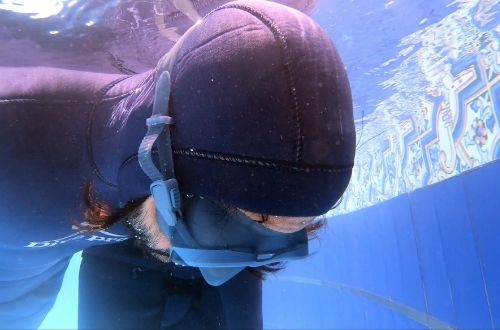Having difficulties managing contractions is perfectly normal in static apnea, and no matter what anyone says, we will never be “friends” with this unpleasant stimulus. Thus, rather than performing a mentally demanding training based on a CO2 table, it may be wise to delay the contractions and prolong the “easy” part of the breath-hold. I propose in this article a complete and detailed description to succeed at best my favorite exercise in static: The ONE contraction table.
Basic principle:
You will perform a series of static apneas that will each be interrupted at the first contraction and interspersed with 2 minutes of recovery.
General recommendation:
Perform this exercise in the water, equipped with a nose clip (and goggles if you want), a snorkel, and of course, with a buddy. You want to wear an adapted wetsuit that will guarantee you to stay warm for 1 hour. It is essential that your buddy is someone who can stay focused on the task (which will be particularly boring) and that they are equipped with a slate to record your times as well as a stopwatch.
Execution:
1. As far as your breathing and preparation is concerned, I recommend that you keep it simple: breathe completely normally, following your activity level (almost zero) while trying to fall asleep. Avoid those big breaths that are supposed to relax you. I recommend doing this preparation with your head in the water and with the snorkel. Your buddy should not even hear your breathing.
2. When you are ready, take a slow, complete and unique breath (forget packing) and remove your snorkel: your buddy can now start the timer.
3. Since there is no question of hyperventilating and you will remain in the “easy” zone, avoid “safety checks” with your buddy (who will keep a watchful eye on you): nothing should distract you. Just try to maintain this state of sleep.
4. When you feel the first contraction coming, try to gently refuse it: like when you want to resist tickling.
5. When the first contraction finally arrives, take the time to make a clean exit: reach out with one hand to the edge, then the other, place your feet under your eyes, raise your head (without standing up) and do your recovery breathing. You will therefore have about 5/10 seconds of apnea beyond your first contraction and NO MORE.
6. Your buddy should then note your time and start a 2-minute timer. Do not ask for your time to your buddy, and do not let him tell/show you (you should make that point clear before the session)
7. As soon as the recovery breath is done, go back to the water with your snorkel and try to fall asleep again: minimal breathing that your buddy should still not hear
8. At the end of the 2-minute stopwatch, your buddy tells you that the time is up. Take one full breath and start your second breath-hold.
You can repeat the operation to make between 5 and 10 breaths hold each until the first contraction: stop yourself if you start to feel cold or tired. Your buddy can also stop you if your apnea time begins to decrease.
Important: make sure that it is only one and unique exercise. You should remain “in your bubble” throughout the entire session, regardless of whether you are in the breath-hold or the recovery phases. Try to discuss everything beforehand with your buddy and thus avoid communication during the exercise. Regarding your breath holds times, you will have plenty of opportunity to analyse them AFTER the session but better cut yourself from this information during the exercise.
What results to expect?
If you have never practiced this type of exercise, you will see a drastic increase in the time without contraction in the times recorded by your buddy. The buddy will also generally notice a reduction in neck tension.
But is this just a “warm-up” effect?
Some of it is indeed due to a form of warm-up but not only. Do not hesitate to repeat this exercise over three consecutive sessions and compare the times: you will notice real progress while remaining in optimal physical and mental comfort.
Why does it work?
The problem with “classic” CO2 tables is that they prepare us to stay calm in the face of an uncomfortable and stressful situation. But by exposing ourselves to this stress, we are also sending a signal to our nervous system that apnea itself is an unpleasant and stressful activity, which inevitably penalizes relaxation for subsequent dives. By making freediving easy and enjoyable, we can somehow “reprogram” our nervous system to not go on alert as soon as we hold our breath and thus extend the “easy” part of our dives safely.
Conclusion
I love this exercise because it allows us to realize in the short term that easy training that aims to increase the quality of our breath holds can work perfectly. The idea of “training hard” or “suck it up” to improve results is a personal choice that should not be seen as an obligation.
To go further
If you would like to go further in the understanding of the logic behind this type of training, go check my article on CO2 tolerance in freediving

